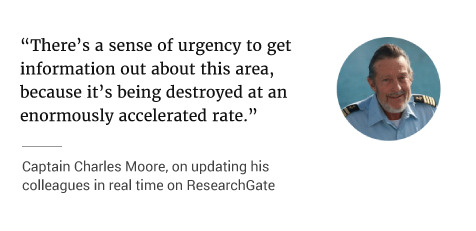
Oceanographer Charles Moore reported the discovery in a ResearchGate project update.

In an update on ResearchGate, a team of scientists has confirmed the existence of another ocean garbage patch, this time in a remote area of the South Pacific. The high degree of plastic pollution was uncovered by captain Charles Moore and his team of volunteer researchers on a six-month voyage. Moore documented the expedition on ResearchGate, where he created a project to announce early observations and findings in real time. It can take months, or even years, to publish research results in a journal. ResearchGate projects allow scientists to discover and follow research like Moore’s as it unfolds.
Unlike the famous patch in the northern Pacific Ocean, which has long been one of the world’s most recognizable symbols of pollution, the new patch is in an area that had previously been largely unstudied. That makes the news about the South Pacific patch extremely valuable to other scientists, like Utrecht University oceanographer Erik van Sebille. He’s just begun an extensive project of his own to track plastic distribution throughout the ocean. “There’s very little information on plastic in the South Pacific. Hardly anybody goes there, and it’s really very poorly studied,” he said. “We need observations like these to constrain our modeling, so I was excited to see Charles’ project.”

Having returned from their expedition, Moore and his team are processing and cleaning their samples, so they can study the plastic more closely. It will be a while before they have results ready to publish—the plastic particles collected at sea have to be carefully weighed and analyzed. But Moore didn’t want to wait to share his initial observations. “There’s a sense of urgency to get information out about this area, because it’s being destroyed at an enormously accelerated rate,” he said.
To learn more about the expedition, visit Captain Moore's project on ResearchGate.
“We discovered tremendous quantities of plastic. My initial impression is that our samples compared to what we were seeing in the North Pacific in 2007, so it’s about ten years behind,” said Moore, who has done work on plastic pollution since he stumbled across the older, North Pacific patch while captaining a racing yacht in the 1990s. Moore says the southern patch could be as big as a million square kilometers, 1.5 times the size of Texas.

While the term “garbage patch” conjures up images of floating bottles and grocery bags, the South Pacific patch is comprised primarily of tiny plastic pieces, smaller than grains of rice. This may indicate that plastic in the South Pacific has a longer journey than the trash in the more infamous patch, which will eventually also break apart. “We found a few larger items, occasionally a buoy and some fishing gear, but most of it was broken into bits,” said Moore. Plastic from fishing gear is so common here because the fishing industry is particularly active in the Southern Hemisphere. “We haven’t yet done lab analysis, but based on my visual impression, an enormous area of the South Pacific has millions of plastic particles per square kilometer,” said Moore.
Once the tiny plastic particles are in the gyre, they’re next to impossible to clean up—the best hope is preventing them at the source, and the sooner the better. “Gone are the silly notions that you can put nets in the ocean and solve the problem,” said Marcus Eriksen, another marine pollution researcher. “This cloud of microplastics extends both vertically and horizontally. It’s more like smog than a patch. We’re making tremendous progress to clean up smog over our cities by stopping the source. We have to do the same for our seas.”